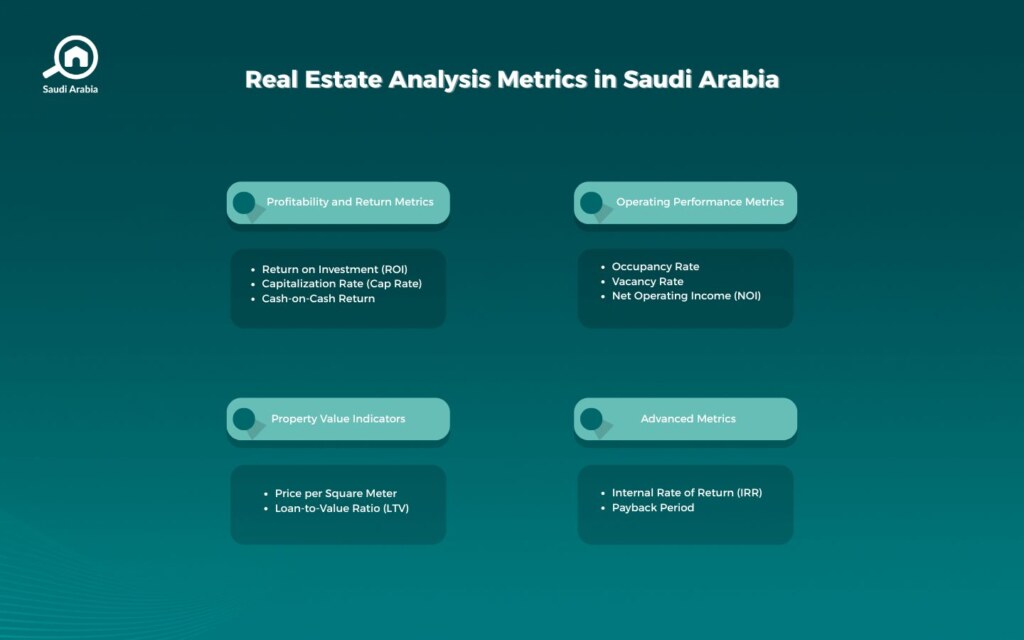Real Estate Analysis in Saudi Arabia is the practical toolkit that separates guesswork from confident investment decisions. Whether you are a first-time buyer, a developer, or a lender, mastering these metrics gives you a factual view of profitability, risk, and market fit. In this guide we translate core Arabic content into clear English, with short paragraphs, friendly explanations, and pointers to official Saudi sources so you can act with confidence.
Real Estate Analysis Metrics in Saudi Arabia
Real Estate Analysis Metrics in Saudi Arabia are the basic building blocks investors use to evaluate a property’s performance. These include return measures (ROI), capitalization rate (cap rate), cash-on-cash return, and net operating income (NOI). Use these metrics to compare opportunities, estimate value, and prioritize investments in cities such as Riyadh, Jeddah, and Dammam.

Real Estate Indicators Analysis
Real Estate Indicators Analysis looks beyond single-property math to market signals: occupancy and vacancy rates, price per square meter, supply pipeline, and mortgage lending trends. These indicators show whether a market is hot, cooling, or correcting—which is essential context when interpreting a property’s numbers.
You may also be interested in our article on the Real Estate Contribution Platform in Saudi Arabia.
Types of Property Valuation
Types of Property Valuation commonly used in Saudi Arabia:
- Market (comparative) approach: compares sales of similar properties.
- Income (capitalization) approach: values property by expected income (using NOI and cap rate).
- Cost approach: estimates replacement cost minus depreciation (used for special-use assets).
Each method has strengths. Income-based valuation (cap rate and NOI) is essential when you want to judge an investment property’s yield rather than its sticker price.
What Are the Property Valuation Standards?
What Are the Property Valuation Standards? In Saudi Arabia, valuations follow standards endorsed by the Saudi Authority for Accredited Valuers (Taqeem) and professional guidelines that emphasize: reliable market data, objectivity, and thorough documentation. Appraisers use the same metrics investors do—NOI, cap rate, price per sqm—to create defensible, auditable valuations.
Learn more about institutional standards and guidance via REGA’s open data and the Ministry of Municipal and Rural Affairs and Housing.
What Are Real Estate Analyses?
What Are Real Estate Analyses? These are structured studies that combine quantitative metrics with qualitative judgment. A proper analysis includes:
- Cash flow modeling (monthly/annual)
- Calculating ROI and cash-on-cash return
- Estimating NOI: total income minus operating expenses
- Applying a cap rate to derive estimated value
- Stress-testing scenarios (vacancy rises, maintenance surprises)
For example, NOI = Total Rental Income − Operating Expenses. Cap rate = NOI ÷ Purchase Price. These formulas power the financial view of every investment decision.
Advanced Metrics Worth Knowing
- Internal Rate of Return (IRR): captures time value of money across multiple years—vital for developments and long-term projects.
- Payback Period: how long until your invested capital is recovered—simple and intuitive.
- Loan-to-Value (LTV): (Loan ÷ Property Value) × 100—critical for lender risk and down-payment sizing.
If you build a simple infographic for your readers, include the formulas for ROI, NOI, cap rate, and cash-on-cash return for quick reference.
Who Uses Real Estate Analysis in Saudi Arabia ?
These metrics are used by:
- Individual investors evaluating buy vs. rent decisions
- Developers planning feasibility studies
- Banks and financing institutions assessing loan risk
- Government bodies tracking market health and policy impact
Programs like Sakani and other housing initiatives influence the market context, so pair property-level analysis with macro-level policy review. Read more about Sakani in our article A Guide to Smarter Real Estate Finance Management in Saudi Arabia.

How Analysis and Valuation Work Together
Real Estate Analysis in Saudi Arabia feeds the valuation process. Analysis tests profitability and risk; valuation translates that into a market price. A valuator will often use NOI and cap rates derived from your analysis to back up an appraisal used for sale, financing, or legal purposes.
Conclusion
Real Estate Analysis in Saudi Arabia is not just a set of numbers; it is the scientific method of property investing. Use the ROI, cap rate, NOI, IRR, and LTV consistently. Cross-check your assumptions with official Saudi data sources, document everything, and rely on short, repeatable calculations to compare options objectively. These metrics are your mirror—use them wisely before you buy, develop, or lend.
For more insights on the Saudi real estate market, career opportunities, and industry updates, visit My Bayut Saudi Blog and follow us on social media for the latest trends.





